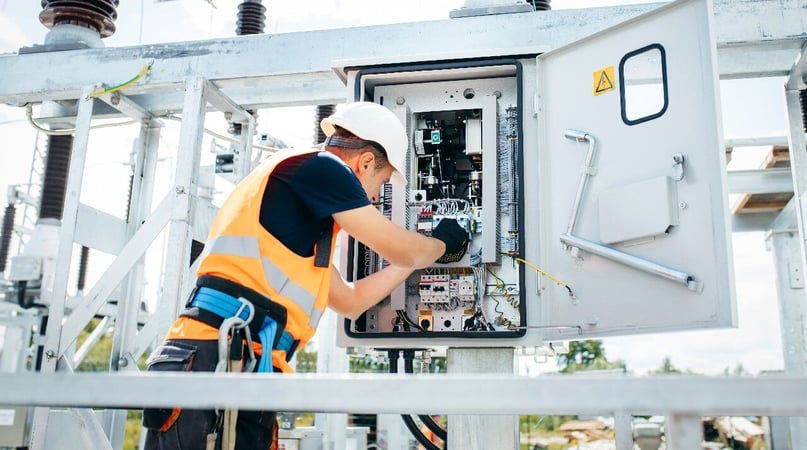
Ensuring Safety and Compliance in Electrical Maintenance: Best Practices and Standards
Safety and compliance are paramount in electrical maintenance. Service and Contract Managers overseeing electrical systems understand that any oversight can lead to severe consequences, from costly legal penalties to life-threatening accidents. Ensuring adherence to the best electrical maintenance practices is a legal obligation and a critical aspect of responsible management. Using our experiences working with electrical maintenance engineers, we’ve written this blog to explore the essential standards, practices, and technologies that can help maintain high safety and compliance levels in electrical maintenance.
Understanding Regulatory Standards
Understanding and navigating the complex regulatory landscape is not just a necessity but a powerful tool for maintaining safety in electrical maintenance. Key regulatory frameworks such as the Electricity at Work Regulations 1989, BS 7671 (IET Wiring Regulations), and the Health and Safety at Work Act set the UK's legal requirements for electrical safety. This knowledge empowers Service and Contract Managers to make informed decisions and ensure compliance.
These regulations demand that all electrical systems be properly maintained to prevent danger, placing a significant responsibility on Service and Contract Managers. Non-compliance can lead to hefty fines, legal action, and severe reputational damage. Moreover, failure to meet these standards directly impacts worker safety, potentially resulting in catastrophic incidents. Thus, staying informed and compliant with these regulations forms the foundation of the best electrical maintenance practices.
Implementing a Comprehensive Safety Programme
A robust safety and compliance programme is essential for mitigating the inherent risks in electrical maintenance. The first step in this process is conducting thorough risk assessments so you can proactively identify and manage potential electrical hazards to mitigate risks before they escalate.
Training and competency are equally vital. Regular training sessions ensure all team members are updated with the latest safety protocols and practices. Competency in handling electrical systems, recognising potential issues, and responding to emergencies are all critical components of a successful safety programme.
The use of appropriate safety equipment and Personal Protective Equipment (PPE) cannot be overstated. From insulated gloves to voltage detectors, ensuring that all personnel have access to and use the correct safety gear is integral to maintaining high safety standards. Integrating these elements into daily operations exemplifies the best electrical maintenance practices.
Best Practices in Electrical Maintenance
Consistency in applying the best electrical maintenance practices is essential for safety and compliance. Regular inspections and testing of electrical systems are fundamental to identifying and resolving potential issues before they lead to significant problems. These inspections should be scheduled frequently, with detailed checklists covering all critical aspects of the electrical systems under management.
Another essential practice is documenting all maintenance activities. Accurate records provide a clear history of maintenance actions and ensure traceability and accountability. Should an incident occur, well-maintained records can demonstrate that all necessary precautions and maintenance were performed.
Another critical aspect is incorporating preventive maintenance strategies. By anticipating and addressing issues before they occur, preventive maintenance reduces downtime and extends the lifespan of electrical equipment. This proactive approach is central to the best electrical maintenance practices, ensuring safety and operational efficiency.
Leveraging Technology for Compliance
Technology is increasingly vital in maintaining compliance and safety in electrical maintenance. For instance, Computerised Maintenance Management Systems (CMMS) and Computer-Aided Facility Management (CAFM) systems offer powerful tools for managing maintenance schedules, tracking compliance tasks, and storing critical data. These systems automate many aspects of maintenance management, reducing the likelihood of human error and ensuring that nothing is overlooked.
The integration of IoT and smart sensors into electrical systems further enhances safety. These devices provide real-time monitoring, allowing for the early detection of anomalies and enabling swift corrective actions. This real-time data is invaluable for Service and Contract Managers, helping them maintain compliance and adhere to the best electrical maintenance practices.
Digital documentation and reporting are also crucial in today’s regulatory environment. Modern digital tools ensure that all records are accurate, easily accessible, and audit-ready, making compliance checks straightforward and stress-free.
Maintaining safety and compliance in electrical maintenance is not just a task but a responsibility that Service and Contract Managers must take seriously. By understanding and adhering to critical regulatory standards, implementing comprehensive safety programmes, and consistently applying the best electrical maintenance practices, they can mitigate risks and ensure the safety of their operations. This commitment to safety and compliance is what sets them apart as responsible managers.
As technology advances, leveraging tools like CMMS, CAFM systems become increasingly important in maintaining high safety and compliance standards. Joblogic offers innovative solutions that can help you stay ahead of these challenges. Book a demo today to discover how our software can support your commitment to safety and compliance in electrical maintenance.